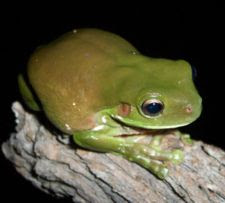Ecology and behaviour
Green Tree Frogs are very docile. They are nocturnal and come out in early evenings to call (in spring and summer) and hunt at night. During the day they find cool, dark, and moist areas to sleep. During winter, Green Tree Frogs do not call and are not usually seen.
Depending on their location, Green Tree Frogs occupy various habitats. Typically, they are found in the canopy of trees near a still-water source. However, they can survive in swamps (among the reeds) or in grasslands in cooler climates. Green Tree Frogs are well known for inhabiting water sources inside houses, such as sinks or toilets. They can also be found on windows eating insects. They will occupy tanks (cisterns), downpipes (downspouts), and gutters, as these have a high humidity and are usually cooler than the external environment. The frogs are drawn to downpipes and tanks during mating season, as the fixtures amplify their call.
The species' call is a low, slow crawk-crawk-crawk, repeated many times. For most of the year, they call from high positions, such as trees and gutters. During mating season the frogs descend, although remaining slightly elevated, and call close to still-water sources, whether temporary or permanent. Like many frogs, Green Tree Frogs call not only to attract a mate. They have been observed calling to advertise their location outside the mating season, usually after rain, for reasons that are uncertain to researchers. They will emit a stress call whenever they are in danger, such as when predators are close or when a person steps on a log in which a frog resides.
The species' diet consists mainly of insects and spiders, but can include smaller frogs and even small mammals. frog teeth are not suited to cutting up prey, so the prey must fit inside the mouth of the frog. Many frogs propel their sticky tongues at prey. The prey sticks, and is consumed. Green Tree Frog will use this technique for smaller prey; however for larger prey, it pounces, then forces the prey into its mouth with its hands.
The frog has few native predators, among them snakes and a few species of lizards and birds. Since the European settlement of Australia, non-native predators have been introduced, primarily dogs and cats. The species has an average life expectancy in captivity of sixteen years, but some have been known to live for over twenty years, which is long for a frog. The average life expectancy in the wild is lower than in captivity, due to predation.
Etymology and taxonomic history
The common name of the species, "White's Tree Frog", is in honour of the first person to describe the species, John White. The Green Tree Frog was the first Australian frog scientifically classified. The species was originally called the "blue frog" (Rana caerulea); although the Green Tree Frog is green, the original specimens White sent to England were damaged by the preservative and appeared blue. This is because the colour of the frog is caused by blue and green pigments covered in a yellow layer. The preservative destroyed the yellow layer and left the frog with a blue appearance. The specific epithet, caerulea, which is Latin for blue, has remained the same. The frog is also known more simply as the "Green Tree Frog." However, that name is often given to the most common large green tree frog in a region, for example, the American green tree frog (Hyla cinerea).
The Green Tree Frog is sometimes confused with the Magnificent Tree Frog (Litoria splendida), which inhabits only north-western Australia and can be distinguished by the presence of large parotoids and rostral glands on the head. The Giant Tree Frog (Litoria infrafrenata) is also sometimes confused with the Green Tree Frog. The main difference is a distinct white stripe along the edge of the lower jaw of the Giant Tree Frog, which is not present in the Green Tree Frog.source : wikipedia










